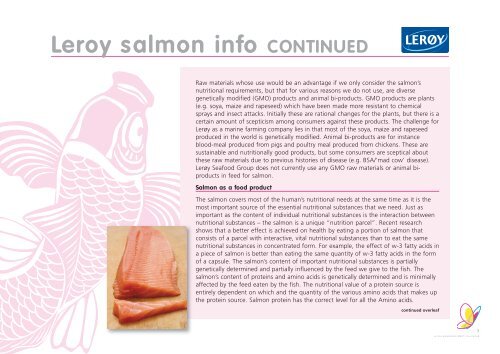salmon itsu
salmon itsu
salmon itsu
You also want an ePaper? Increase the reach of your titles
YUMPU automatically turns print PDFs into web optimized ePapers that Google loves.
Leroy <strong>salmon</strong> info CONTINUED<br />
Raw materials whose use would be an advantage if we only consider the <strong>salmon</strong>’s<br />
nutritional requirements, but that for various reasons we do not use, are diverse<br />
genetically modified (GMO) products and animal bi-products. GMO products are plants<br />
(e.g. soya, maize and rapeseed) which have been made more resistant to chemical<br />
sprays and insect attacks. Initially these are rational changes for the plants, but there is a<br />
certain amount of scepticism among consumers against these products. The challenge for<br />
Lerøy as a marine farming company lies in that most of the soya, maize and rapeseed<br />
produced in the world is genetically modified. Animal bi-products are for instance<br />
blood-meal produced from pigs and poultry meal produced from chickens. These are<br />
sustainable and nutritionally good products, but some consumers are sceptical about<br />
these raw materials due to previous histories of disease (e.g. BSA/’mad cow’ disease).<br />
Lerøy Seafood Group does not currently use any GMO raw materials or animal biproducts<br />
in feed for <strong>salmon</strong>.<br />
Salmon as a food product<br />
The <strong>salmon</strong> covers most of the human’s nutritional needs at the same time as it is the<br />
most important source of the essential nutritional substances that we need. Just as<br />
important as the content of individual nutritional substances is the interaction between<br />
nutritional substances – the <strong>salmon</strong> is a unique “nutrition parcel”. Recent research<br />
shows that a better effect is achieved on health by eating a portion of <strong>salmon</strong> that<br />
consists of a parcel with interactive, vital nutritional substances than to eat the same<br />
nutritional substances in concentrated form. For example, the effect of w-3 fatty acids in<br />
a piece of <strong>salmon</strong> is better than eating the same quantity of w-3 fatty acids in the form<br />
of a capsule. The <strong>salmon</strong>’s content of important nutritional substances is partially<br />
genetically determined and partially influenced by the feed we give to the fish. The<br />
<strong>salmon</strong>’s content of proteins and amino acids is genetically determined and is minimally<br />
affected by the feed eaten by the fish. The nutritional value of a protein source is<br />
entirely dependent on which and the quantity of the various amino acids that makes up<br />
the protein source. Salmon protein has the correct level for all the Amino acids.<br />
continued overleaf<br />
an <strong>itsu</strong> presentation ©2011 <strong>itsu</strong> limited<br />
9


